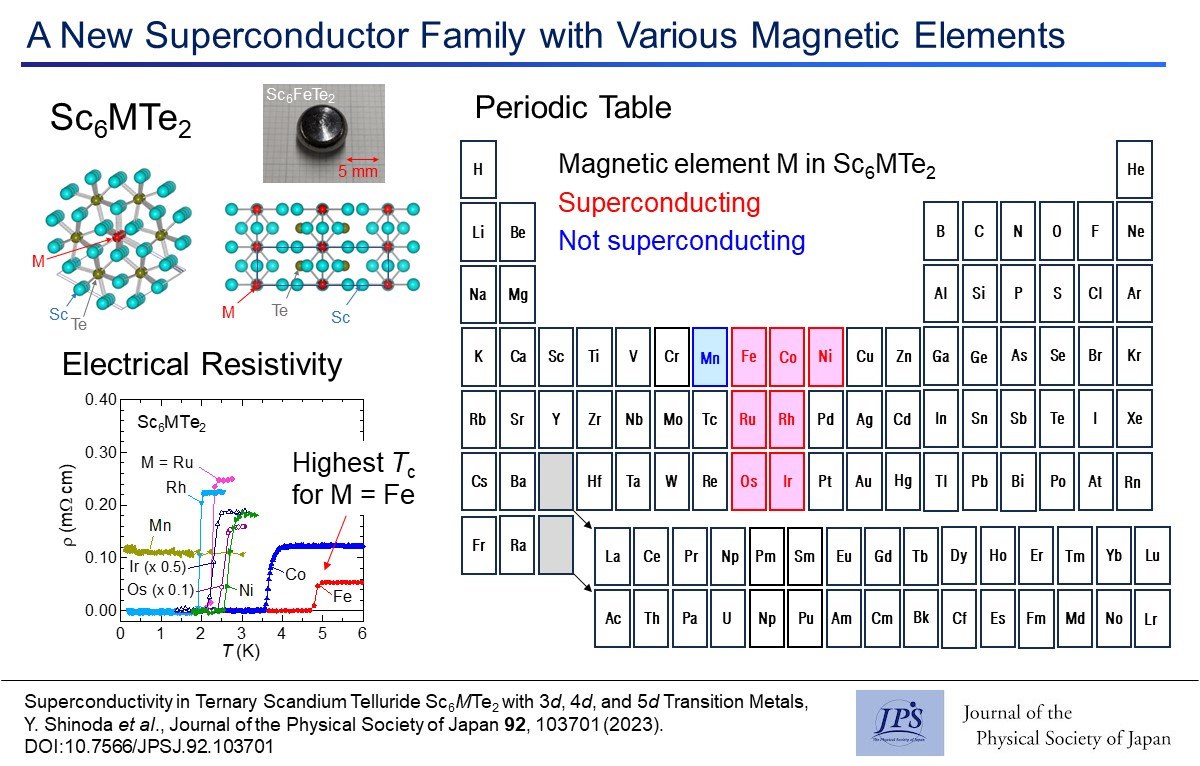A New Superconductor Family with Various Magnetic Elements
© The Physical Society of Japan
This article is on
Superconductivity in Ternary Scandium Telluride Sc6MTe2 with 3d, 4d, and 5d Transition Metalss
(JPSJ Editors' Choice)
J. Phys. Soc. Jpn. 92, 103701 (2023).
A new superconductor family, Sc6MTe2, has been discovered, comprising seven variations with magnetic elements labeled as M. Notably, only a few known superconductor families exist that involve various magnetic elements.

Understanding the connection between superconductivity, which is when a material loses all electrical resistance at low temperatures, and magnetism, a magnetic property of material, is significantly intricate. Normally, strong magnetism disrupts superconductivity; hence, materials with magnetic elements like iron tend not to exhibit superconductivity. However, materials containing magnetic elements rarely display unconventional superconductivity with remarkably high transition temperatures or unusual characteristics that defy existing theories. Unraveling the complex relationship between superconductivity and magnetism may be crucial for achieving superconductivity at room temperature. Discovering unique superconductors plays a key role in shedding light on this condition.
We investigated a family of materials, Sc6MTe2, consisting of scandium (Sc), tellurium (Te), and various magnetic elements like iron, cobalt, and nickel. These materials exhibit superconductivity in different cases, with specific superconducting transition temperatures varying depending on the magnetic element. For instance, Sc6FeTe2 boasts the highest transition temperature of Tc = 4.7 K. Families of superconductors containing diverse magnetic elements are quite rare. We anticipate that further research on this superconductor family will enhance our understanding of the interplay between superconductivity and magnetic elements.
Author: Yoshihiko Okamoto, representing all the authors.
Superconductivity in Ternary Scandium Telluride Sc6MTe2 with 3d, 4d, and 5d Transition Metalss
(JPSJ Editors' Choice)
J. Phys. Soc. Jpn. 92, 103701 (2023).
Share this topic
Fields
Related Articles
-
d2 Trimer and d3 Tetramer in a Pyrochlore Lattice
Dielectric, optical, and other properties in condensed matter
Electron states in condensed matter
2024-7-11
Based on the charge disproportionation of V3+ and V2+, the V3+(d2) trimers and V2+(d3) tetramers in the vanadium pyrochlore lattice of AlV2O4 are described by the orbitally-induced Peierls mechanism.
-
Evaluation of the Exchange Stiffness Constants of Itinerant Magnets from the First-Principles Calculations
Electron states in condensed matter
Structure and mechanical and thermal properties in condensed matter
2024-6-5
Using first-principles calculations, we evaluated the exchange stiffness constants of ferromagnetic metals at finite temperatures. The constants can be used as parameters in the Landau–Lifshitz–Gilbert equation.
-
Microscopic Exploration of Electronic States in Nickelate Superconductors
Magnetic properties in condensed matter
Superconductivity
2024-5-31
The multilayered nickelates, La3Ni2O7 and La4Ni3O10 , were investigated using nuclear magnetic resonance (NMR) at ambient pressure. Metallic electronic states under the density wave order were observed microscopically for both compounds.
-
Single-Crystal Growth of a Cuprate Superconductor with the Highest Critical Temperature
Superconductivity
2024-5-20
Millimeter-sized single crystals of a trilayer cuprate superconductor (Hg,Re)Ba2Ca2Cu3O8+δ that exhibits the highest superconducting transition temperature under ambient pressure, were grown reproducibly and safely.
-
Cooking in Salt for Ultra-Clean Superconductor UTe2
Superconductivity
2024-4-30
A new crystal growth technique, the molten salt flux liquid transport method, was developed to produce high-quality single crystals of spin-triplet superconductor UTe2. This method is promising for exploring the exotic superconductivity of other materials.
